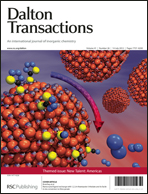Generation of [(IPr)Pd(PR2Cl)] complexes via P–Cl reductive elimination†
Abstract
Treatment of [(IPr)Pd(Cl)2(PR2H)] (IPr = 1,3-bis(2,6-diisopropylphenyl)imidazol-2-ylidene; R = Cy, tBu, or 1-Ad) with NaN(SiMe3)2 generated isolable [(IPr)Pd(PR2Cl)] complexes (68–75%) that have been crystallographically characterized. The formation of these mixed-
![Graphical abstract: Generation of [(IPr)Pd(PR2Cl)] complexes via P–Cl reductive elimination](/en/Image/Get?imageInfo.ImageType=GA&imageInfo.ImageIdentifier.ManuscriptID=C1DT11910A&imageInfo.ImageIdentifier.Year=2012)
- This article is part of the themed collection: New Talent: Americas

 Please wait while we load your content...
Please wait while we load your content...